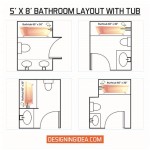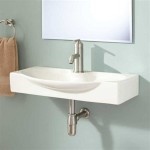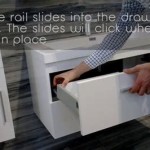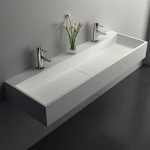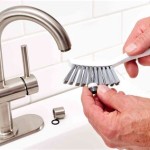Cleaning a Bathroom Sink P-Trap: A Comprehensive Guide
The bathroom sink P-trap, a U-shaped pipe located under the sink, is a crucial component of a plumbing system. Its primary function is to trap debris and prevent sewer gases from entering the bathroom. Over time, hair, soap scum, toothpaste, and other materials accumulate in the P-trap, leading to clogs and unpleasant odors. Regular cleaning of the P-trap is essential for maintaining proper drainage and a hygienic bathroom environment. This article provides a detailed guide on how to effectively clean a bathroom sink P-trap.
Understanding the Function of the P-Trap
The P-trap operates on a simple yet effective principle. The U-shape of the pipe always holds a small amount of water. This water creates a seal that blocks sewer gases, which are often noxious and potentially harmful, from rising through the drain and into the bathroom. Without a properly functioning P-trap, these gases could permeate the air, creating an unpleasant and unhealthy living space. Furthermore, the P-trap acts as a catch basin for heavy debris. Items accidentally dropped down the drain, such as jewelry or small objects, are often caught in the P-trap, preventing them from entering the main drain line, where they could cause more significant blockages. Therefore, the P-trap serves a dual purpose: preventing sewer gas intrusion and trapping debris.
The location of the P-trap, directly under the sink, makes it easily accessible for maintenance and cleaning. Its design is relatively simple, typically consisting of three main parts: the inlet pipe connecting to the sink drain, the U-shaped bend, and the outlet pipe connecting to the drain line in the wall. These parts are usually connected with slip nuts, which allow for easy disassembly and reassembly without the need for specialized tools or plumbing expertise.
Safety Precautions Before Cleaning
Before embarking on the cleaning process, several safety precautions should be taken to minimize risks and ensure a smooth operation. First and foremost, it is important to protect oneself from potential exposure to bacteria and contaminants. Wearing rubber gloves is essential to prevent direct contact with the wastewater and debris that may be present in the P-trap. Eye protection, such as safety glasses or goggles, is also recommended to guard against splashes or debris that could potentially enter the eyes. These precautions are crucial for maintaining personal hygiene and preventing the spread of germs.
In addition to personal protection, it is vital to prepare the work area. Placing a bucket or basin under the P-trap is necessary to catch any water or debris that will spill out when the trap is disconnected. This prevents water damage to the floor and helps to contain the mess. It is also advisable to have old towels or rags readily available to wipe up any spills or drips that may occur during the cleaning process. Good lighting is also essential; ensuring adequate illumination of the work area will improve visibility and make the task easier and safer.
Step-by-Step Guide to Cleaning the P-Trap
Cleaning a bathroom sink P-trap is a straightforward process that can be accomplished with a few basic tools and some patience. By following these steps, a homeowner can effectively remove clogs and maintain proper drainage.
Step 1: Gather Necessary Tools and Materials
Before starting, gather all the necessary tools and materials. This includes:
- Rubber gloves
- Safety glasses
- Bucket or basin
- Adjustable wrench or pliers
- Old towels or rags
- Small brush or wire (optional)
Having these items readily available will streamline the cleaning process and prevent unnecessary delays.
Step 2: Prepare the Work Area
Place the bucket or basin directly under the P-trap to catch any water or debris. Spread old towels or rags around the area to protect the floor from spills. Ensure there is adequate lighting to see clearly.
Step 3: Loosen the Slip Nuts
Using an adjustable wrench or pliers, carefully loosen the slip nuts that connect the P-trap to the drain pipes. It is important to note that these nuts should be loosened gently, not completely removed, to avoid damaging the pipes or stripping the threads. Work slowly and steadily to prevent any accidental breakage or leakage. Loosen the nuts on both sides of the U-bend. If the nuts are particularly tight, use penetrating oil to help loosen them.
Step 4: Disconnect the P-Trap
Once the slip nuts are loosened, carefully disconnect the P-trap. Hold the P-trap firmly in place as the last nut is loosened, as there will likely be water and debris inside. Gently lower the P-trap into the bucket or basin to contain the contents. Be prepared for a surge of water and debris to spill out.
Step 5: Empty and Clean the P-Trap
Empty the contents of the P-trap into the bucket or basin. Inspect the inside of the P-trap and remove any accumulated debris, such as hair, soap scum, or other materials. A small brush or wire can be helpful for dislodging stubborn debris. Rinse the P-trap thoroughly with water to ensure all debris is removed. If the P-trap is heavily soiled, use a mild detergent and a scrub brush to clean the interior. Ensure the P-trap is completely clear of any obstructions before proceeding.
Step 6: Inspect the Drain Pipes
While the P-trap is disconnected, take the opportunity to inspect the drain pipes that connect to the P-trap. Look for any signs of blockage or corrosion. If there is any debris visible in the drain pipes, use a small brush or wire to carefully remove it. Flushing the drain pipes with water can also help to clear any remaining debris. Ensure the drain pipes are clean and free of obstructions to prevent future clogs.
Step 7: Reassemble the P-Trap
Once the P-trap and drain pipes are cleaned, carefully reassemble the P-trap. Align the P-trap with the drain pipes and tighten the slip nuts by hand. Ensure the nuts are snug but not overly tight to avoid damaging the pipes. Once the nuts are hand-tightened, use an adjustable wrench or pliers to give them a final tightening. Again, be careful not to over-tighten the nuts, as this can strip the threads or crack the pipes.
Step 8: Test for Leaks
After reassembling the P-trap, it is essential to test for leaks. Turn on the water and allow it to run for a few minutes. Carefully inspect the connections between the P-trap and the drain pipes for any signs of leakage. If any leaks are detected, tighten the slip nuts further. If the leaks persist, the nuts may be overtightened or the washers may be damaged. In this case, disassemble the P-trap and inspect the washers for damage. Replace any damaged washers and reassemble the P-trap. Retest for leaks.
Preventive Measures for Maintaining a Clean P-Trap
Regular maintenance and preventive measures can significantly reduce the frequency of P-trap cleaning and prevent future clogs. These strategies help to minimize the accumulation of debris and maintain proper drainage.
Using Drain Screens or Strainers
One of the most effective ways to prevent clogs is to use drain screens or strainers. These simple devices fit into the drain opening and catch hair, soap scum, and other debris before they enter the P-trap. Drain screens are inexpensive and easy to install, making them a practical solution for maintaining a clean drain system. Regular cleaning of the drain screen is essential to prevent it from becoming clogged itself. Simply remove the screen and rinse it under running water to remove any accumulated debris.
Flushing the Drain Regularly
Regularly flushing the drain with hot water can help to prevent the buildup of soap scum and other materials. Hot water helps to dissolve and wash away these substances before they accumulate and cause clogs. Run hot water down the drain for several minutes at least once a week to maintain proper drainage. Adding a small amount of dish soap to the hot water can further enhance its cleaning power.
Avoiding the Disposal of Certain Items
Avoid disposing of certain items down the drain that can contribute to clogs. These include grease, coffee grounds, and food scraps. Grease solidifies as it cools and can adhere to the inside of the pipes, causing blockages. Coffee grounds and food scraps can accumulate and form solid masses that restrict water flow. Dispose of these items in the trash instead of down the drain to prevent clogs.
Periodic Drain Cleaning Solutions
Periodic use of drain cleaning solutions can also help to maintain a clean P-trap. There are various types of drain cleaning solutions available, including enzymatic cleaners and chemical drain cleaners. Enzymatic cleaners use enzymes to break down organic matter, such as hair and soap scum. These cleaners are generally considered to be safer and more environmentally friendly than chemical drain cleaners. Chemical drain cleaners use harsh chemicals, such as sodium hydroxide or sulfuric acid, to dissolve clogs. These cleaners can be effective, but they can also be corrosive and potentially harmful to the pipes. Use chemical drain cleaners with caution and always follow the manufacturer's instructions.
By following these preventive measures, homeowners can significantly reduce the frequency of P-trap cleaning and maintain a healthy and efficient plumbing system. Regular maintenance and attention to detail can prevent costly repairs and ensure proper drainage in the bathroom.

How To Unclog Clean A Bathroom Sink Drain 3 Methods

Clog Fix Clean Out P Trap Bathroom Sink Drain

How To Unclog Clean A Bathroom Sink Drain 3 Methods

How To Unclog A Sink The Right Way

How To Unclog A Bathroom Sink Hana S Happy Home

How To Clean Bathroom Drains Unclog Your Shower And Sink

How Often To Clean Your P Trap Expert Tips For Drain Maintenance Plumbco

What Is A P Trap Family Handyman

How To Clean A P Trap Or U Bend 10 Steps With Pictures

How To Clean A Bathroom Sink Drain
Related Posts

